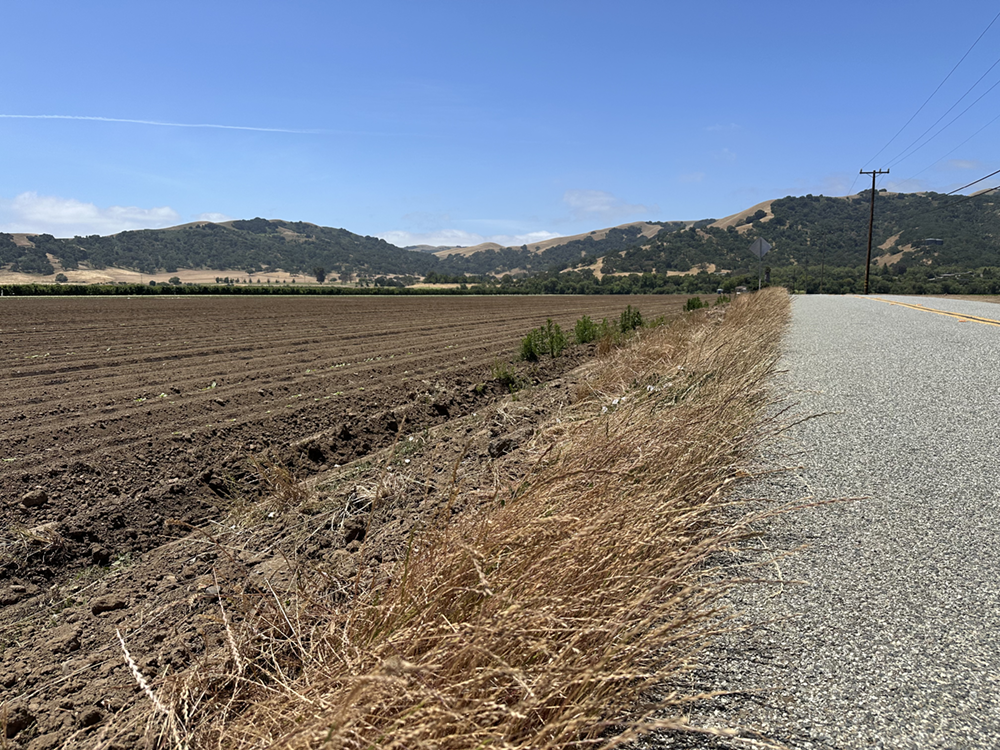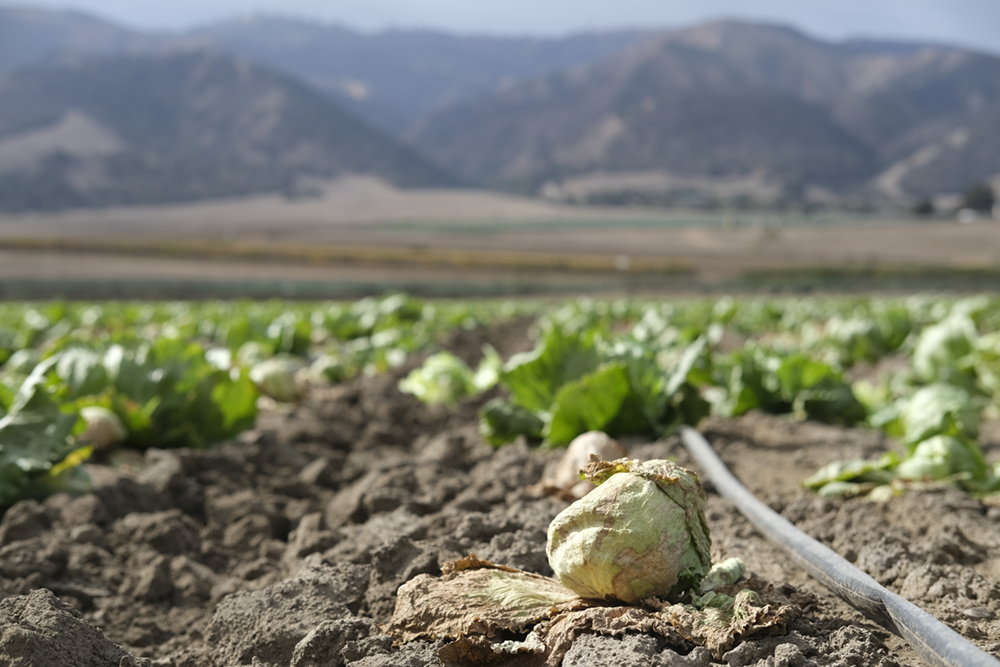Weeding, weather aid battle in controlling lettuce virus

Weed control near farms is a critical part of prevention efforts for impatiens necrotic spot virus. The disease, which can be devastating to lettuce crops, finds hosts in weeds and is spread by thrips.
Photo/Natalie Hanson


Photo/Caleb Hampton
By Natalie Hanson
California lettuce growers are so far breathing a sigh of relief that the dreaded impatiens necrotic spot virus that has devastated Salinas Valley lettuce crops in recent years seems to have receded.
But agricultural researchers warn that it will take extensive work and vigilance to prevent a future outbreak that could be costly for affected crops.
For Monterey County farmer Ryan Kelly, that vigilance includes weeding every day early in the morning. Kelly, farm manager at Boutonnet Farms in Castroville, said weeding is essential to keep tabs on disease spreading thrips and area plants on which the virus, or INSV, can live.
“We try to be as preventative as possible and keep things as clean as possible,” Kelly said. “Occasionally, we get the people that let things go a little longer than you might want, but for the most part, things have been better.”
Kelly is among the growers who are working again this season to avoid another outbreak of INSV, an obligate parasite that finds hosts in plants, including winter weeds, and is vectored through western flower thrips.
It can wreak havoc on lettuce crops during the growing season. Salinas Valley farmers in 2022 suffered an estimated $150 million in crop losses, more than tripling the damages from 2021.
Last year, exceptionally wet and cold conditions from atmospheric river storms resulted in a dramatic reduction in INSV infections. This year, farmers, agricultural officials and scientists are working to keep infection levels from rising anew through monitoring and aggressively targeting potential weed hosts for the disease.
“It is hard to evaluate whether or not the weed abatement program is working, but the industry is optimistic that it has made a difference,” said Jennifer Clarke, executive director of the California Leafy Greens Research Board. “I think that is something that time will help us evaluate.”
Growers in the Salinas Valley are getting help through county weed abatement efforts and from California Department of Transportation crews that clean up weeds along Highway 101 on the southern end of the valley.
“Hopefully, they’re getting to it sooner rather than later, because it’s still pretty plugged up along that stretch of Highway 101, along the northern end of the corridor,” Kelly said.
There is another benefit of preventive weeding: It costs less to do so preemptively than to face the potential high costs of crop damage if any crops are impacted by INSV, Kelly added.
“Even if it costs a little bit more money, I think it’s worth more to me in the long run than if I let it go,” he said.
Yu-Chen Wang, plant pathologist advisor at the University of California Cooperative Extension in Monterey County, said things are finally looking up in the state’s INSV hotspot thanks to efforts by Salinas Valley growers.
“So far, we have seen a low population of thrips and a low incidence of INSV,” Wang said. “This is a good start for the rest of the season, because the virus level may continue building up along with the thrips population increasing in the summer.”
Wang said part of the reason for success this time around lies with growers’ weed management. Even when a grower controls winter weeds in or near their own fields, the virus can find a home in weeds growing in nearby fields and survive. One INSV infestation in 2022 was traced back to weeds on an industrial site as far as 100 yards away.
That’s why abatement must continue, especially in known hotspots such as Soledad, Gonzales and Castroville, Wang said.
Mary Zischke of the Grower-Shipper Association, who manages the organization’s INSV Task Force, said she has been keeping a close eye on abatement and other INSV prevention efforts.
The task force has been active since fall 2020, during the first of a series of “disastrous” INSV infections in lettuce crops. A group of growers organized to address impacts of INSV meets biweekly to stay on top of the issue.
“During the worst of the epidemic, we were meeting on a weekly basis with growers, the research community, farm advisors—whoever might be able to help with the problem,” Zischke said. “It’s a chance for growers and pest management to interface with scientists and keep that dialogue going.”
Scientists continue to look for genetic remedies for the disease. Kelley Richardson, a U.S. Department of Agriculture research geneticist based in Salinas, said two greenhouse trials are underway in the hopes of screening lettuce varieties for potential resistance to INSV and another disease, Pythium wilt.
Researchers have identified the 10 top weeds that serve as hosts for INSV and have set up traps throughout the Salinas Valley to monitor populations of thrips. They caution that the disease is usually more severe later in the year, meaning there’s no relaxing for farmers.
“Fall is the time when thrips pressure and INSV would be the highest,” Clarke said.
Ian Grettenberger, a UCCE entomologist, said it is too early to know the impacts of INSV from weedy thrips.
“We still have plenty of time left in the season for incidents to get worse in fields,” Grettenberger said. “Warm weather helps generate thrips and build populations among crops and non-crops, creating more vectors moving around in the landscape.”
Zischke said growers must also do their part by monitoring weeds on neighbors’ nearby land.
“The growers are looking at areas that they don’t have control over in adjacent areas, and they’re working with the ag commissioner on weed abatement,” she said. “I get calls all the time (about) weeds in an abandoned area or an industrial property.
“We’re all pulling together,” she added. “You can’t just think it’s just your neighbor’s problem.”
Mark Mason of Salinas-based vegetable and strawberry grower Nature’s Reward, agreed this is no time to slow on abatement.
“We’re very aggressive on weed abatement—hoeing and thinning, keeping the ditches clean, the roadsides,” Mason said. “We’re all in it together.”
(Natalie Hanson is a reporter in Alameda County. She may be contacted at natalie.hanson96@gmail.com. Bob Johnson, a reporter in Monterey County, contributed to this report and may be contacted at bjohn11135@gmail.com.)




